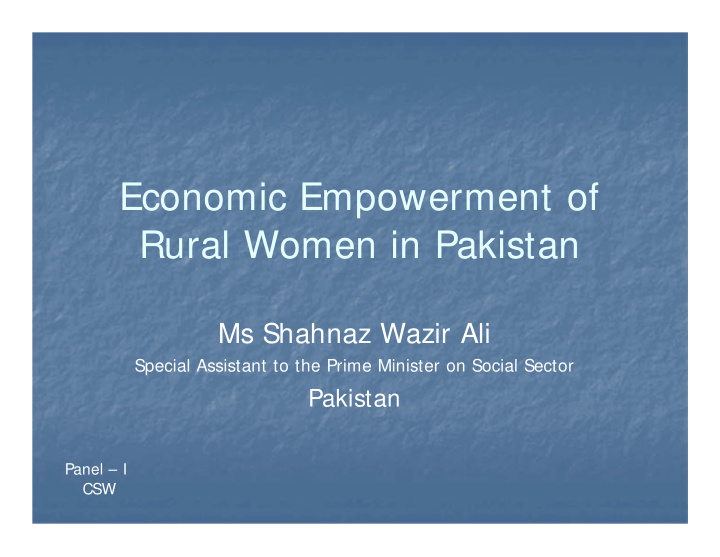



Economic Empowerment of Rural Women in Pakistan Ms Shahnaz Wazir Ali Special Assistant to the Prime Minister on Social Sector Pakistan Panel – I CSW
Population – Pakistan Total Population 180.71 million (2012) Female: 87 M 70 63 Male: 93 M 51 60 48 Rural Areas 113 M 50 37 Female 40 Urban Areas: 67 M Male 30 Rural Urban 20 10 0 Female Male Rural Urban Economic Survey of Pakistan 2010-11
Overall Rural Literacy Rate : 49 % Female : 35% Male : 63% 63 70 60 49 50 35 40 Overall Female 30 Male 20 10 0 Overall Female Male Economic Survey of Pakistan 2010-11
Nutrition Status of Women RDA/ Capita per Day 2500 2150 2370 2000 1700 1500 Food Basket Food Availability 1000 Consumption 500 0 Food Basket Food Availability Consumption
Urban & Rural Mothers In Rural areas 48% Mothers are getting below the RDA In Urban areas 50% Mothers are getting below the RDA
Economic Status of Rural Women in Pakistan Share in Employment Land Ownership Access to Financial Resources Access to Technology Women in Rural Infrastructure
Share in Employment Adult Women 61.3M Women in the Labour Force 12.098 M 0.15% 15.46% Employer 0.018 M 63.48% 20.91% Self ‐ Employed 1.87M Employed 2.53 M Unpaid Family Member 7.68 M Employer Self Employed Employed Unpaid Family Member 7
Dynamics of the Female Labor Force (2010/11)
Land Ownership Women in Pakistan have a legal right to own land under statutory, religious, and customary law. In the Previous, Land Reforms Failed to Allot Land Titles to Women as a Right Major initiative of present Government 2010 Awarded of State Land to Landless women Haris in Sindh Province
Benazir Income Support Programme
Impact of Microfinance & Benazir Income Support Programme (BISP) + I ncrease in female borrowers to 55% of total borrowers, allowing greater female economic I ncrease in I ncome: empowerment 90% higher income for active borrowers vs. non + I ncrease in borrowers or new borrowers individual borrowers, growing entrepreneurial activity
...With different institutional Models I nfrastructure 8 Microfinance Banks (MFBs) 4 Rural Support Programs (RSPs) 9 Specialized Microfinance Institutions (MFIs) 8 NGOs 12
% of Women Microfinance Borrowers 60.00% 40.00% 20.00% Pakistan 0.00% Source: Social Performance Report 2009. Pakistan Microfinance Network. 2010. World regions data: MIX Market
60% rural coverage Percentage of rural women borrowers to total rural borrowers – 56% Percentage of rural women borrowers to total borrowers – 25%
BISP - gives the female heads of the eligible families PK Rs. 1,000 per month. Experiences from cash transfer and conditional cash transfer programs elsewhere have shown that transferring cash to women in households can increase their decision ‐ making power (Schultz 1990; Thomas 1990; Gitter and Barham 2008). Level of support being provided through BISP is minimal and has been designed to supplement income from a job, never replace it. The injection of cash into particularly poor communities is helping stimulate the local economy
Govt. Initiatives to Empower Women The Government taking measure BISP Microfinance To train women in preserving and processing of various fruits, vegetables and livestock Assist rural women in marketing their products
Recommend
More recommend